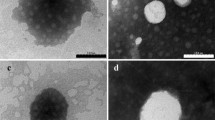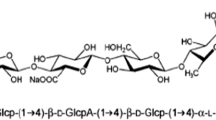Abstract
Timolol Maleate is used as a first-line treatment for open-angle glaucoma. It has low bioavailability and poor therapeutic effects because of the rapid precorneal removal of the conventional formulation. A study has found a selection of container closure that was safe, efficient, and stable for the formulation of multi-stimuli-responsive ocular sustained in situ hydrogels. The timolol maleate in situ gelling method was optimized and characterized in order to obtain desired quality attributes. Bulk preparations were autoclave sterilized (121 °C, 15 pressure for 20 min) and then filled into a specified container closing system. An accelerated stability analysis was carried out on optimized ocular formulation in accordance with ICH guidelines. The degradation rate for the optimized ocular formulation was found to be exceptionally low (1998 × 10−4 day−1) during stability testing. From the stability results, in situ gelling systems may assigned two years of shelf life.
Graphical abstract




Similar content being viewed by others
References
Lee DA, Higginbotham EJ (2005) Glaucoma and its treatment: a review. Am J health-Syst Pharm 62:691–9
Fechtner RD, Realini T (2004) Fixed combinations of topical glaucoma medications. Curr Opin Ophthalmol 15:132–135
Wu Y, Liu Y, Li X, Kebebe D, Zhang B, Ren J, Lu J, Li J, Du S, Liu Z (2019) Research progress of in-situ gelling ophthalmic drug delivery system. Asian J Pharm Sci 14:1–5
Sahu T, Ratre YK, Chauhan S, Bhaskar LV, Nair MP, Verma HK (2021) Nanotechnology based drug delivery system: Current strategies and emerging therapeutic potential for medical science. J Drug Deliv Sci Technol 63:102487
Majeed A, Khan NA (2019) Ocular in situ gel: An overview. J Drug Deliv Therapeutics 9:337–47.
Liechty WB, Kryscio DR, Slaughter BV, Peppas NA (2010) Polymers for drug delivery systems. Annu Rev Chem biomolecular Eng 1:149
Patel GC, Parmar VK, Patel PS (2018) Stimuli-responsive polymers for ocular therapy. Stimuli Responsive Polym. Nanocarriers Drug Deliv Appl 2:463–489. Adv. Nanocarriers Ther
Patel P, Patel G (2021) Formulation, ex-vivo and preclinical in-vivo studies of combined ph and ion-sensitive ocular sustained in situ hydrogel of timolol maleate for the treatment of glaucoma. Biointerface Res Appl Chem 11:8242–8265
Patel P, Patel G (2021) Formulation development and optimization of phasetransition w/o microemulsion in situ gelling system for ocular delivery of timolol maleate in the treatment of glaucoma. Biointerface Res Appl Chem 11:9097–9112
Konstas AG, Mantziris DA, Maltezos A, Cate EA, Stewart WC (1999) Comparison of 24 h control with Timoptic [R] 0.5% and Timoptic-XE [TM] 0.5% in exfoliation and primary open-angle glaucoma. Acta Ophthalmologica Scandinavica 77:541–543
ICH Harmonised Tripartite Guideline Q1B (1997) Note for Guidance on the photostability testing of New Active Substances And Medicinal Products. ICH Harmonised Tripartite Guideline Q1B. 59:104–107. https://www.ema.europa.eu/en/documents/scientific-guideline/ich-q-1-b-photostability-testing-new-active-substances-medicinal-products-step-5_en.pdf
Bajaj S, Singla D, Sakhuja N (2012) Stability testing of pharmaceutical products. J Appl Pharmaceutical Sci 2:129–138
Thakare V, Mayr B, Artenjak A, Nianios D, Sest M, Müller M, Maltsev OV, Nowicki K, Mischo A, Ehrenstrasser C, Fink M (2019) Investigation of drug product and container-closure interactions: A case study of diluent containing prefilled syringe. Eur J Pharmaceutics Biopharmaceutics 140:67–77
Chauhan A, Jindal T (2020) Good microbiological laboratory practices. In Microbiological methods for environment, food and pharmaceutical analysis (pp. 15–22). Springer, Cham. Springer Nature Switzerland AG 2020
Karthikeyan D, Sonkar S, Pandey VP, Kumar JN, Sengottuvelu S, Bhowmick M, Shivakumar T (2008) Development and characterization of modified ocular inserts with improved ocular compatibility. Res J Pharm Technol 1:93–99
Moser CL, Meyer BK (2011) Comparison of compendial antimicrobial effectiveness tests: a review. Aaps Pharmscitech 12:222–226
Samadi N, Tarighi P, Fazeli MR, Mehrgan H (2015) Evaluation of antimicrobial effectiveness of ophthalmic drops according to the pharmacopeial tests criteria. DARU J Pharm Sci 17:13–18
Oliva A, Fariña J, Llabrés M (1996) Influence of temperature and shaking on stability of insulin preparations: degradation kinetics. Int J pharmaceutics 143:163–170
Hathout RM, Omran MK (2016) Gelatin-based particulate systems in ocular drug delivery. Pharm Dev Technol 21:379–386
Wu C, Qi H, Chen W, Huang C, Su C, Li W, Hou S (2007) Preparation and evaluation of a Carbopol®/HPMC-based in situ gelling ophthalmic system for puerarin. Yakugaku Zasshi 127:183–191
Cohen TH, Sauvageon-Martre H, Brossard D, Hermies FD, Bardin C, Chast F, Chaumeil JC (1996) Amphotericin B eye drops as a lipidic emulsion. Int J pharmaceutics 137:249–254
Ferreira SB, Moço TD, Borghi-Pangoni FB, Junqueira MV, Bruschi ML (2016) Rheological, mucoadhesive and textural properties of thermoresponsive polymer blends for biomedical applications. J Mech Behav Biomed Mater 55:164–178
Madan M, Bajaj A, Lewis S, Udupa N, Baig JA (2009) In situ forming polymeric drug delivery systems. Indian J Pharm Sci 71:242
Acknowledgements
The authors are thankful to Ms. Bindu Yadav & Ms. Riya Patel, PhD scholars of Ramanbhai Patel College of Pharmacy, Charotar University of Science and Technology (CHARUSAT) for their extended support.
Author contributions
All authors contributed to the study conception, material preparation, and data analysis. The first draft of the manuscript was written by Priya Patel and all authors commented on previous versions of the manuscript. All authors read and approved the final manuscript.
Author information
Authors and Affiliations
Corresponding author
Ethics declarations
Conflict of interest
The authors declare no competing interests.
Additional information
Publisher’s note Springer Nature remains neutral with regard to jurisdictional claims in published maps and institutional affiliations.
Rights and permissions
Springer Nature or its licensor (e.g. a society or other partner) holds exclusive rights to this article under a publishing agreement with the author(s) or other rightsholder(s); author self-archiving of the accepted manuscript version of this article is solely governed by the terms of such publishing agreement and applicable law.
About this article
Cite this article
Patel, P., Patel, P. & Patel, G. Container closure selection and stability studies of developed multistimuli-responsive ocular sustained in situ hydrogel formulation of timolol maleate. J Sol-Gel Sci Technol 105, 443–450 (2023). https://doi.org/10.1007/s10971-022-06006-5
Received:
Accepted:
Published:
Issue Date:
DOI: https://doi.org/10.1007/s10971-022-06006-5




